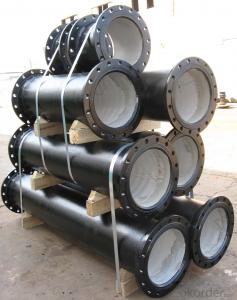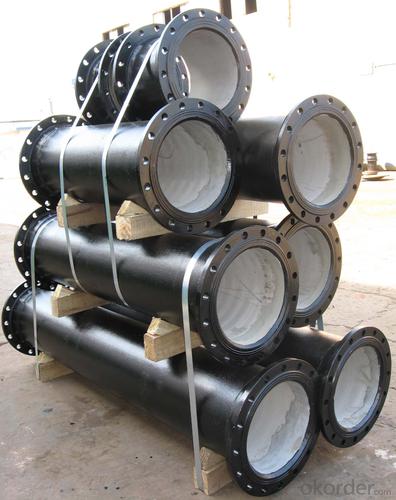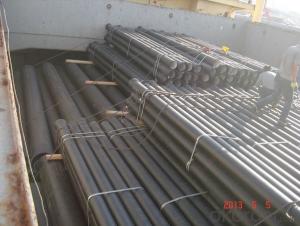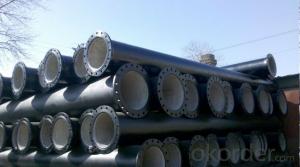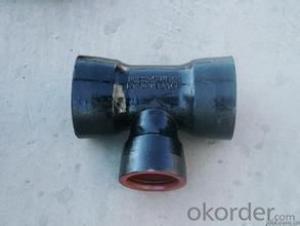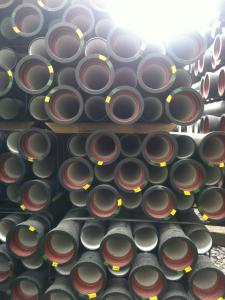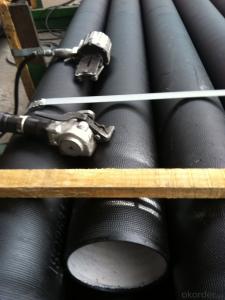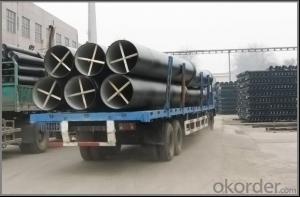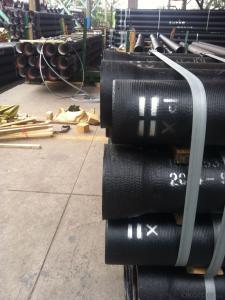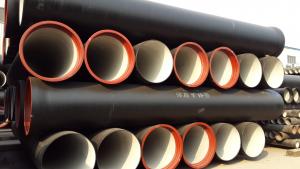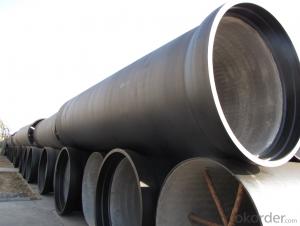D.I PIPE FITTINGS K12 CLASS DN350 FLANGED
- Loading Port:
- Tianjin
- Payment Terms:
- TT OR LC
- Min Order Qty:
- 25 m.t
- Supply Capability:
- 30000 m.t/month
OKorder Service Pledge
OKorder Financial Service
You Might Also Like
Material : Ductile Cast Iron
Size Range : DN 80mm to DN 2000mm
Unit Effective Length : 6m or 5.7m
Manufacture Standard: ISO 2531:1998/ EN 545:2006/EN 598:2007
Annual capacity : 200,000 tons
Coating Exterior: Zinc 130g/m2 according to ISO 8179-1 and bitumen coating 70 microns.
Cement Interior: Portland Cement/ High Alumina Cement/ Sulphate Resisting Cement Lining according to ISO 4179
Special requirements on external coating and internal lining can be applied
We also provide accessories such as SBR/EPDM rubber gaskets, lubricant paste, pipe caps, PE sleeves, etc.
Additional Parts:
Each pipe is strictly inspected according to related standard to ensure permanently high performance.
Easy Installation at site and service free for life
Long Service Lifespan
Quotation will arrive you within 24hours once we get your inquiry.
We guarantee offering you a competitive price.
A copy of original inspection reports of pipes will be offered after shipment.
Photos of loading process will be sent to the customer after shipment effect.
We will follow-up the delivery progress after shipment effect and update to the customer on weekly basis.
- Q: Can ductile iron pipes be used for industrial applications?
- Yes, industrial applications can utilize ductile iron pipes. Ductile iron, a form of cast iron, possesses enhanced mechanical characteristics compared to traditional cast iron. These improvements include increased ductility and strength. Consequently, ductile iron pipes are highly appropriate for industrial applications that require durability, strength, and resistance to external forces. Industrial applications often necessitate the transportation of high-pressure water or fluids. Ductile iron pipes are specifically designed to endure such circumstances. Their exceptional tensile strength enables them to withstand deformation and fractures. This quality renders them optimal for managing heavy loads and enduring significant internal and external pressures. Moreover, ductile iron pipes exhibit exceptional resistance to corrosion, rendering them remarkably suitable for industrial applications that entail exposure to harsh chemicals or corrosive substances. The pipes' resistance to corrosion ensures a prolonged lifespan and decreases maintenance expenses associated with pipe replacements or repairs. Furthermore, ductile iron pipes are renowned for their adaptability and versatility. They can be seamlessly connected and integrated into existing infrastructure, making them the preferred choice for industrial applications. The pipes' impressive strength-to-weight ratio facilitates easy handling and installation, a crucial aspect in industrial settings. In conclusion, ductile iron pipes are well-suited for industrial applications due to their enhanced mechanical properties, corrosion resistance, and versatility. Their ability to endure high pressures, resist deformation, and adapt to existing infrastructure establishes them as an exceptional choice for various industrial applications.
- Q: What are the common methods for cutting ductile iron pipes?
- There are several common methods for cutting ductile iron pipes, depending on the specific requirements and tools available. 1. Hand Saw: A hand saw with a carbide-tipped blade is commonly used for cutting smaller diameter ductile iron pipes. This method requires physical effort and may be time-consuming. 2. Reciprocating Saw: A reciprocating saw with a diamond or carbide abrasive blade is a more efficient option for cutting ductile iron pipes. This power tool allows for faster cutting and requires less physical effort. 3. Cut-Off Saw: A cut-off saw, also known as a chop saw or disc cutter, equipped with a diamond or abrasive blade is a popular method for cutting ductile iron pipes. This power tool provides precise and fast cuts, making it suitable for both small and large diameter pipes. 4. Band Saw: A band saw with a bi-metal or carbide-tipped blade is commonly used for cutting larger diameter ductile iron pipes. This method allows for clean and precise cuts, but it may require specialized equipment and expertise. 5. Grinding Wheel: In some cases, a grinding wheel with a diamond or abrasive disc can be used to cut ductile iron pipes. This method is suitable for smaller diameter pipes or when other cutting tools are not available. It is important to note that regardless of the method used, proper safety precautions should always be followed, including wearing appropriate protective gear and using clamps or vices to secure the pipe during cutting. Additionally, it is recommended to consult with professionals or manufacturers' guidelines for specific recommendations on cutting ductile iron pipes.
- Q: What are the specifications of cast iron pipes?
- Compared with grey cast iron pipe, ductile iron pipe has higher strength, better toughness, thinner tube wall, less metal consumption, and can bear higher pressure. The effective length is 5 meters and 6 meters. According to the wall thickness, it is divided into two grades P and G. It is the development direction of cast iron pipe.
- Q: What are ductile iron pipes?
- Ductile iron pipes are a type of iron piping that possess unique properties, making them highly durable and flexible. They are made by adding small amounts of magnesium to cast iron, which transforms the brittle material into a stronger and more malleable form. Due to their high tensile strength and ability to withstand extreme conditions, ductile iron pipes are commonly used in various applications such as water and sewage systems, industrial plants, and transportation infrastructure.
- Q: Are ductile iron pipes resistant to chemical attacks?
- Yes, ductile iron pipes are generally resistant to chemical attacks. Ductile iron is known for its high corrosion resistance, making it suitable for a wide range of applications including water and wastewater systems. Ductile iron pipes are typically lined with a protective coating such as cement mortar or epoxy to further enhance their resistance to chemical attacks. This lining acts as a barrier between the pipe material and the corrosive substances, preventing any degradation of the iron. However, it is important to note that the level of resistance can vary depending on the specific chemical being transported and the concentration and temperature of the solution. Therefore, it is always advisable to consult with experts or engineers to ensure the suitability of ductile iron pipes for specific chemical environments.
- Q: Does the cast iron have size 250? What's the performance?
- 1, cast iron because of low melting point, casting process performance is good, because it has been widely used.2, the relative gray iron ductile iron, have higher tensile strength and impact toughness, which has better mechanical performance.
- Q: Can ductile iron pipes be used for wastewater reuse projects?
- Yes, ductile iron pipes can be used for wastewater reuse projects. Ductile iron is a strong and durable material that can withstand the corrosive nature of wastewater. It is commonly used in wastewater treatment plants and distribution systems for its ability to handle high-pressure and heavy loads. Additionally, ductile iron pipes have a long lifespan, making them a reliable choice for wastewater reuse projects.
- Q: Are ductile iron pipes suitable for wastewater treatment plants?
- Yes, ductile iron pipes are suitable for wastewater treatment plants. Ductile iron is a strong and durable material that is resistant to corrosion, making it an ideal choice for handling wastewater, which can contain various corrosive elements. Additionally, ductile iron pipes have high tensile strength and can withstand high pressure, which is necessary for transporting wastewater in a treatment plant. The flexibility of ductile iron pipes also allows for easy installation and maintenance, reducing the overall cost and time required for a wastewater treatment plant. Overall, ductile iron pipes are widely used in wastewater treatment plants due to their durability, corrosion resistance, and ability to handle the demanding conditions present in such facilities.
- Q: How are ductile iron pipes protected against erosion caused by high-velocity flow?
- Various methods and techniques are used to protect ductile iron pipes from erosion caused by high-velocity flow. One effective method involves applying protective coatings on the inner surface of the pipes. These coatings act as a barrier between the flowing water and the pipe material, minimizing the abrasive effects of the fast flow. Depending on the specific requirements of the application, coatings such as epoxy, polyurethane, or cement-mortar lining may be used. In addition, manufacturers often design the pipes with increased wall thickness in areas prone to erosion, such as bends or sections with high flow velocity. This additional thickness provides extra strength and resistance against erosion. Another technique used to safeguard ductile iron pipes from erosion is the implementation of flow control devices, such as flow deflectors or fittings that reduce velocity. These devices help redirect the flow and decrease its speed, thus minimizing the impact on the pipe walls. Regular maintenance and inspections are also vital to prevent erosion. By monitoring the condition of the pipes and identifying any early signs of erosion, appropriate measures can be taken to address the issue before it worsens. This may involve repairing or replacing damaged sections of the pipes and implementing erosion control measures like sediment filters or flow restrictors. Overall, a combination of protective coatings, design considerations, flow control devices, and proactive maintenance strategies are employed to ensure adequate protection of ductile iron pipes against erosion caused by high-velocity flow.
- Q: Can ductile iron pipes be repaired if they get damaged?
- Yes, ductile iron pipes can be repaired if they get damaged. The repair process typically involves cutting out the damaged section and replacing it with a new pipe segment or using repair clamps to fix minor leaks or cracks.
Send your message to us
D.I PIPE FITTINGS K12 CLASS DN350 FLANGED
- Loading Port:
- Tianjin
- Payment Terms:
- TT OR LC
- Min Order Qty:
- 25 m.t
- Supply Capability:
- 30000 m.t/month
OKorder Service Pledge
OKorder Financial Service
Similar products
Hot products
Hot Searches
Related keywords
